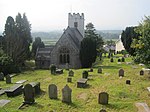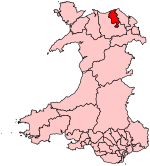Brynbella
Country houses in WalesGrade II* listed buildings in DenbighshireHouses in DenbighshireRegistered historic parks and gardens in DenbighshireSalusbury family ... and 2 more
TremeirchionUse British English from July 2022

Brynbella is a neoclassical villa built near the village of Tremeirchion in Denbighshire, northeast Wales, by Hester Piozzi and her husband, Gabriel Piozzi. It was the seat of the Salusbury family from 1794 until 1920. The name is part Welsh and part Italian, meaning "Beautiful Hill" (bryn + bella).
Excerpt from the Wikipedia article Brynbella (License: CC BY-SA 3.0, Authors, Images).Brynbella
B5429,
Geographical coordinates (GPS) Address External links Nearby Places Show on map
Geographical coordinates (GPS)
| Latitude | Longitude |
|---|---|
| N 53.241 ° | E -3.3771 ° |
Address
Brynbella
B5429
LL16 4EN , Tremeirchion
Wales, United Kingdom
Open on Google Maps









